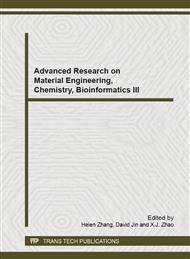p.306
p.310
p.314
p.319
p.323
p.327
p.331
p.337
p.341
Experimental Study on Ammonia-Nitrogen Removal in Water by Composite Zeolite Filter
Abstract:
Using composite zeolite filter material independent preparation in the laboratory as an aeration biological filter material,and compared with ceramsite.The ammonia-nitrogen adsorption capacity of the above two filters were evaluated through the pilot test. The start-up of pilot scale CBAF (BAF filled with compound filter material) showed that the average NH4+-N removal rate of the first 5 days was 52.36% when the average influent NH4+-N concentration was 37mg/L. In steady operation condition, the average NH4+-N removal rate reached 83.51% and the average effluent NH4+-N concentration was 5.81mg/L, which could meet the first degree of national wastewater discharge standard (GB 8978-1996).
Info:
Periodical:
Pages:
323-326
Citation:
Online since:
October 2013
Authors:
Price:
Сopyright:
© 2014 Trans Tech Publications Ltd. All Rights Reserved
Share:
Citation:


